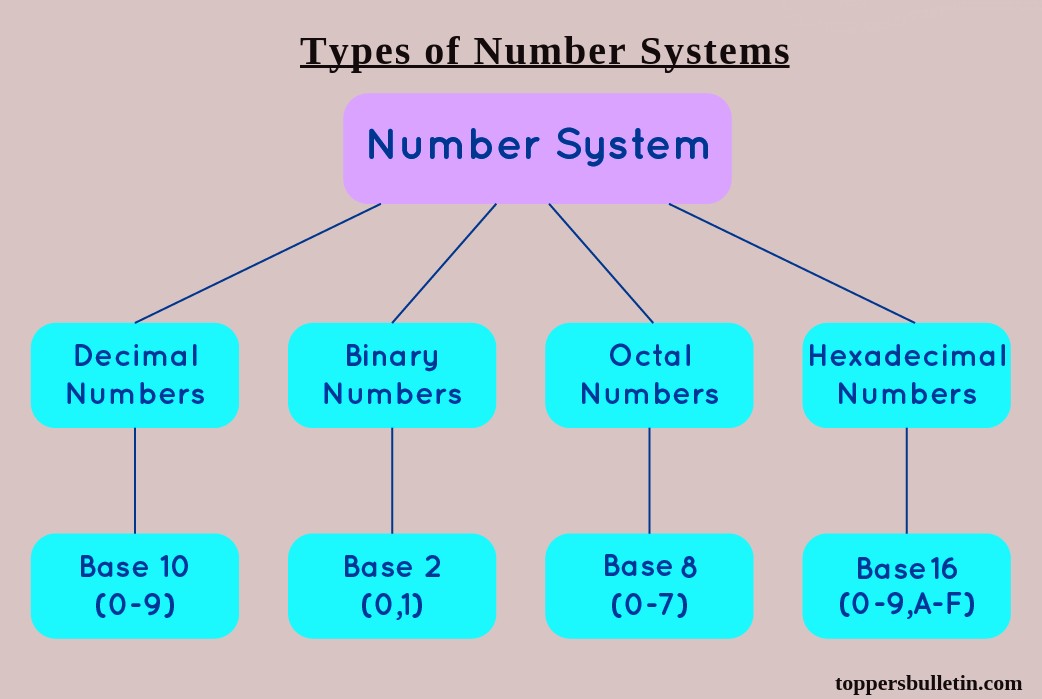What are Number Systems?
Number systems provide a way to represent quantities and values using a unique set of symbols. The most commonly used number system is the decimal system, which uses ten digits (0-9). However, computers and digital systems use other number systems such as binary, octal, and hexadecimal.
Types of Number Systems
There are several types of number systems, including
- Binary number system (Base – 2)
- Octal number system (Base – 8)
- Decimal number system (Base – 10)
- Hexadecimal number system (Base – 16)
Decimal Number System
The decimal system is the most familiar and widely used number system, which uses ten digits (0-9). Each digit represents a value that is a power of 10.
For example, in the number 123, the digit 1 represents 100, the digit 2 represents 20, and the digit 3 represents 3. Therefore, the value of 123 is 1 x 100 + 2 x 10 + 3 x 1 = 123.
Binary Number System
The binary system uses only two digits, 0 and 1. It is the foundation of all digital computing systems. Each digit in a binary number represents a power of 2.
For example, in the binary number 1011, the digit 1 represents 2^3, the digit 0 represents 2^2, the digit 1 represents 2^1, and the digit 1 represents 2^0. Therefore, the value of 1011 in binary is 1 x 2^3 + 0 x 2^2 + 1 x 2^1 + 1 x 2^0 = 11 in decimal.
Octal Number System
The octal system uses eight digits (0-7). Each digit in an octal number represents a power of 8.
For example, in the octal number 73, the digit 7 represents 8^1, and the digit 3 represents 8^0. Therefore, the value of 73 in octal is 7 x 8^1 + 3 x 8^0 = 59 in decimal.
Hexadecimal Number System
The hexadecimal system uses 16 digits (0-9 and A-F). Each digit in a hexadecimal number represents a power of 16. The letters A through F represent values 10 through 15.
For example, in the hexadecimal number AB2, the digit A represents 10 x 16^2, the digit B represents 11 x 16^1, and the digit 2 represents 2 x 16^0.
Therefore, the value of AB2 in hexadecimal is 10 x 16^2 + 11 x 16^1 + 2 x 16^0 = 2738 in decimal.
Conversion of Number Systems
Converting Binary to Decimal Number System: A Step-by-Step Guide
Binary is a base-2 number system, while decimal is a base-10 number system. Converting a binary number to a decimal number may seem challenging, but with the following steps, it’s easy to do.
Step 1: Write down the binary number
The first step is to write down the binary number that you want to convert. For example, let’s convert the binary number 1011 to decimal.
Step 2: Assign powers of 2 to each digit
Starting from the right side of the binary number, assign powers of 2 to each digit. The rightmost digit has a power of 2^0, the next digit has a power of 2^1, the next has a power of 2^2, and so on.
For example, for the binary number 1011, the rightmost digit (1) has a power of 2^0, the next digit (1) has a power of 2^1, the next digit (0) has a power of 2^2, and the leftmost digit (1) has a power of 2^3.
Step 3: Multiply each digit by its corresponding power of 2
Next, multiply each digit by its corresponding power of 2.
For example, for the binary number 1011, we have:
1×2^3 + 0x2^2 + 1×2^1 + 1×2^0
Step 4: Add the products together
Finally, add the products together to get the decimal equivalent of the binary number. Continuing from the previous step, we have:
1×2^3 + 0x2^2 + 1×2^1 + 1×2^0 = 8 + 0 + 2 + 1 = 11
Therefore, the binary number 1011 is equivalent to the decimal number 11.

